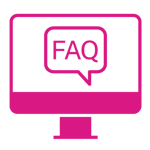- Home
- >Frequently Asked Questions (FAQs)
- >Breast screening
Breast screening
Breast screening can detect breast cancers early and save lives.
Breast screening
A breast screen (or mammogram) is a set of x-rays of your breasts. A breast screen can find cancers as small as a grain of rice, before you can feel or notice a change.1536
Screening with BreastScreen NSW is for well women. If you notice any breast changes or symptoms, please see your doctor as soon as possible.
A breast screen can find cancers before they can be seen or felt.1536 When breast cancer is found early, women have more treatment options available and a better chance of getting well again.1473
BreastScreen NSW recommends women aged 50–74 have a mammogram every 2 years.
For women aged 50–74 screening mammograms are the most effective way to detect breast cancer early and increase the chance of survival.1550
The breast cancer death rate has decreased by almost half (45%) since the BreastScreen Australia Program began* for women aged 50–74.1474
If you’re aged 50–74, we recommend a breast screen every 2 years. We will send you an invitation for your breast screens. A small number of women may need a breast screen every year. We will let you know if this applies to you. Speak to your doctor if you are worried.
No. You don’t need a doctor’s referral, but please bring your doctor’s details to your breast screen if you would like them to receive your results.
All breast screens with BreastScreen NSW are free.
Yes, all BreastScreen NSW radiographers are female.
BreastScreen NSW offers mammography as the primary screening tool. Evidence shows that this is the most effective screening test for finding breast cancer early.1550
We use ultrasound to assist with further investigation if something shows up on a breast screen that needs more clarification.
Screening with BreastScreen NSW is for well women who DO NOT have any breast symptoms.
If you notice changes in your breasts, such as a lump, pain or nipple discharge, please see your doctor as soon as possible.
There is a small chance that a breast screen can appear normal, while a cancer is actually present. A very small number of women are diagnosed with breast cancer between their regular screens. If you notice a breast change that is unusual for you, see your doctor as soon as possible.
For women aged 50–74, a breast screen is the most effective screening test for finding breast cancer early.1550
A breast screen will expose you to a small amount of radiation. Modern x-ray screening equipment uses the smallest amount of radiation possible while still getting a high-quality x-ray image.1537
Research shows the benefits of a breast screen outweigh the risks of radiation exposure.
We use breast screens because they are the best way to find breast cancer early. To obtain a clear picture, the screening machine will press your breast firmly for 10-15 seconds. There are usually 2 images taken of each breast. Some women find the pressing uncomfortable, but it is only for a brief time. If you feel uncomfortable, please tell our staff. You can stop the breast screen at any time.
The pressure used to take a breast x-ray image is important to stop any movement that could blur the image. It also spreads the overlapping tissue in the breast. Your breast will be pressed for about 10 to 15 seconds for each image. There is no evidence that the pressure harms the tissue. Please let our staff know if anything worries you during the screen. They will do their best to make you more comfortable.
The BreastScreen NSW program is designed to detect cancers when they are small, so that women have more treatment options available and an improved chance of survival. Most breast cancers found through screening would grow and become harmful if not treated, but a small number may not. Because some cancers may not become harmful, this is sometimes called overdiagnosis. However, there is currently no way of determining which cancers are likely to grow and become harmful and which may not, based on their appearance on a mammogram.1551
The term ‘overdiagnosis’ does not mean an error or a misdiagnosis but refers to breast cancer detected by screening that would not otherwise go on to cause harm.
If you don’t see your answer, look under ‘Your breast screen FAQs’.



